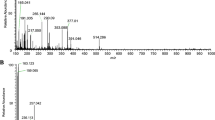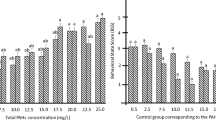Abstract
Although the efficiency of haloxyfop-p-methyl ester (HPME) as selective herbicide is acknowledged, its impact on non-target organisms is poorly known. It is not known whether the short exposure of mammals to low HPME concentrations (consistent with a realistic contamination scenario) poses risks to these animals. Thus, the aim of the current study is to evaluate the effects of HPME on the anti-predatory behavior of female Swiss mice exposed to it. The animals were divided in groups: non-exposed (control) and exposed (route: i.p., for 2 days) to different herbicide concentrations (2.7 × 10−4 g/kg and 2.7 × 10−2 g/kg of body weight), which were considered environmentally relevant predicted concentrations. The animals were subjected to the open field and elevated plus-maze tests; results showed that the HPME did not lead to anxiolytic or anxiety behavior, or to locomotive changes in the tested animals, fact that was confirmed through the Basso Mouse Scale for locomotion scores. On the other hand, animals exposed to the herbicide were incapable of recognizing the snake as potential predator. Animals in the control group, exposed to a real snake (Pantherophis guttatus) remained longer in the safety zone of the test device, presented lower frequency of self-grooming behaviors for a shorter period-of-time, besides showing longer freezing time, which was not observed in animals exposed to HPME. Therefore, our study indicates the ecotoxicological potential of the herbicide, since anti-predatory behavior disorders may affect preys’ responses and population dynamics.







Similar content being viewed by others
References
Abdollahi M, Ranjbar A, Shadnia S, Nikfar S, Rezaiee A (2004) Pesticides and oxidative stress: a review. Med Sci Monit 10:144–147
Banaś A, Johansson I, Stenlid G, Stymne S (1993) Investigation of the mode of action of the herbicide haloxyfop. Zesz Nauk Wyższ Szk Roln P Siedlce Ser Nauki Przyrodnicze 34:1–19
Basso DM, Fisher LC, Anderson AJ, Jakeman LB, McTigue DM, Popovich PG (2006) Basso Mouse Scale for locomotion detects differences in recovery after spinal cord injury in five common mouse strains. J Neurotrauma 23:635–659
Blanchard DC, Li CI, Hubbard D, Markham CM, Yang M, Takahashi LK, Blanchard RJ (2003) Dorsal premammillary nucleus differentially modulates defensive behaviors induced by different threat stimuli in rats. Neurosci Lett 345(3):145–148
Cardoso LS, Estrela FN, Chagas TQ, da Silva WAM, Costa DRO, Pereira I, Vaz BG, Rodrigues ASL, Malafaia G (2018) The exposure to water with cigarette residue changes the anti-predator response in female Swiss albino mice. Environ Sci Pollut Res 25(9):8592–8607
Carpender SE, Caraco NF, Correll DL, Howarth RW, Sharpley AN, Smith VH (1998) Nonpoint pollution of surface waters with phosphorus and nitrogen. Ecol Appl 8(3):559–568
Crist E, Mora C, Engelman R (2017) The interaction of human population, food production, and biodiversity protection. Science 356(6335):260–264
Estrela DC, da Silva WA, Guimarães AT, de Oliveira Mendes B, da Silva Castro AL, da Silva Torres IL, Malafaia G (2015) Predictive behaviors for anxiety and depression in female Wistar rats subjected to cafeteria diet and stress. Physiol Behav 151:252–263
European Food Safety Authority (2014) Reasoned opinion on the review of the existing maximum residue levels (MRLs) for haloxyfop-P. EFSA J 12:3861–3921
Fernández-Teruel A, Estanislau C (2016) Meanings of self-grooming depend on an inverted U-shaped function with aversiveness. Nat Rev Neurosci 17:591
Frings H, Frings M, Kivert A. Behavior patterns of the laboratory mouse under auditory stress. J. Mammal., 32 (1951), pp. 60–76
Glinka ME, Samuels BA, Diodato A, Teillon J, Feng Mei D, Shykind BM, Hen R, Fleischmann A (2012) Olfactory deficits cause anxiety-like behaviors in mice. J Neurosci 32(19):6718–6725
Hansen NC, Gupta SC, Moncrief JF (2000) Herbicide banding and tillage effects on runoff, sediment, and phosphorus losses. J Environ Qual 29:1555–1560
Janssens L, Stoks R (2003) Predation risk causes oxidative damage in prey. Biol Lett 9(4):20130350
Janssens L, Stoks R (2014) Chronic predation risk reduces escape speed by increasing oxidative damage: a deadly cost of an adaptive antipredator response. PLoS One 9(6):e101273
Kalueff AV, Tuohimaa P (2005) Mouse grooming microstructure is a reliable anxiety marker bidirectionally sensitive to GABAergic drugs. Eur J Pharmacol 508:147–153
Kalueff AV, Stewart AM, Song C, Berridge KC, Graybiel AM, Fentress JC (2016) Neurobiology of rodent self-grooming and its value for translational neuroscience. Nat Rev Neurosci 17(1):45–59
Kavaliers M, Choleris E (2001) Antipredator responses and defensive behavior: ecological and ethological approaches for the neurosciences. Neurosci Biobehav Rev 5(7–8):577–586
Korte SM (2001) Corticosteroids in relation to fear, anxiety and psychopathology. Neurosci Biobehav Rev. 25(2):117–42
Kunwar P, Zelikowky M, Remedios R, Cai H, Yilmaz M, Meister M, Anderson DJ (2015) Ventromedial hypothalamic neurons control a defensive emotion state. eLife 4:e06633
Martinez RCR, Carvalho-Netto EF, Amaral VCS, Nunes-de-Souza RL, Canteras NS (2008) Investigation of the hypothalamic defensive system in the mouse. Behav Brain Res 192:185–190
Mendes BO, Rabelo LM, E Silva BC, de Souza JM, da Silva Castro AL, da Silva AR, de Lima Rodrigues AS, Malafaia G (2017) Mice exposure to tannery effluents changes their olfactory capacity, and their response to predators and to the inhibitory avoidance test. Environ Sci Pollut Res 24(23):19234–19248
Olayinka ET, Ore A (2015) Hepatotoxicity, nephrotoxicity and oxidative stress in rat testis following exposure to haloxyfop-p-methyl ester, an aryloxyphenoxypropionate herbicide. Toxics 3(4):373–389
Ore A, Olayinka ET (2017) Fluazifop- p-butyl, an aryloxyphenoxypropionate herbicide, diminishes renal and hepatic functions and triggers testicular oxidative stress in orally exposed rats. Toxicol Ind Health 33(5):406–415. https://doi.org/10.1177/0748233716657763
Pereira FCM, Alves PLCA (2015) Herbicides for weed control in eucalypt. Revista Brasileira de Herbicidas 14(4):333–347
Quintão TC, Rabelo LM, Alvarez TGS, Guimarães AT, Rodrigues ASL, Cardoso LS, Ferreira RO, Malafaia G (2018) Precopulatory sexual behavior of male mice is changed by the exposure to tannery effluent. Chemosphere 195:312–324
Ramankutty N, Mehrabi Z, Waha K, Jarvis L, Kremen C, Herrero M, Rieseberg LH (2018) Trends in global agricultural land use: implications for environmental health and food security. Ann Rev Plant Biol. https://doi.org/10.1146/annurev-arplant-042817-040256
Ramos A (2008) Animal models of anxiety: do I need multiple tests? Trends Pharmacol Sci 39(10):493–498
Souza JM, Rabelo LM, de Faria DBG, Guimarães ATB, da Silva WAM, Rocha TL, Estrela FN, Chagas TQ, de Oliveira Mendes B, Malafaia G (2018) The intake of water containing a mix of pollutants at environmentally relevant concentrations leads to defensive response deficit in male C57Bl/6J mice. Sci Total Environ 628-629:186–197
Takahashi LK (2014) Olfactory systems and neural circuits that modulate predator odor fear. Front Behav Neurosci 11(8):72
Tiffany PB, Mollenauer S, Plotnik R, White M (1979) Olfactory bulbectomy: emotional behavior and defense responses in the rat. Physiol Behav 47(1):311–317
Wang L, Chen IZ, Lin D (2015) Collateral pathways from the ventromedial hypothalamus mediate defensive behaviors. Neuron 85:1344–1358
Zahid HJ, Robinson E, Kelly RL (2016) Agriculture, population growth, and statistical analysis of the radiocarbon record. Proc Natl Acad Sci 113(4):931–935
Acknowledgments
The authors are grateful to the Brazilian National Council for Research (CNPq) (Brazilian research agency) (Proc. No 467801/2014-2) and to Instituto Federal Goiano for the financial support (Proc. No 23219000096/2018-93). Moreover, the authors are grateful to CAPES and FAPEG for granting the scholarship to the student who developed the current study.
Author information
Authors and Affiliations
Corresponding author
Ethics declarations
Conflict of interest
The authors declare that they have no conflict of interest.
Ethical approval
All the herein adopted procedures were approved by the Ethics Committee on Animal Use of Goiano Federal Institute (Comissão de Ética no Uso de Animais do Instituto Federal Goiano), GO, Brazil (Protocol no. 6339041117). Meticulous efforts were made to assure that the animals suffered the least possible and to reduce external stress, pain, and discomfort sources. The current study did not exceed the number of animals necessary to produce trustworthy scientific data. The present article does not contain studies with human participants performed by any of the authors.
Additional information
Responsible editor: Philippe Garrigues
Rights and permissions
About this article
Cite this article
de Oliveira Mendes, B., Mesak, C., Calixto, J.E.D. et al. Mice exposure to haloxyfop-p-methyl ester at predicted environmentally relevant concentrations leads to anti-predatory response deficit. Environ Sci Pollut Res 25, 31762–31770 (2018). https://doi.org/10.1007/s11356-018-3222-5
Received:
Accepted:
Published:
Issue Date:
DOI: https://doi.org/10.1007/s11356-018-3222-5




